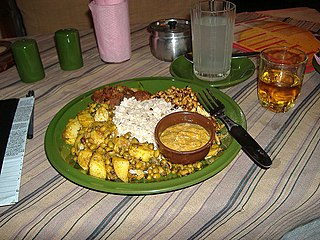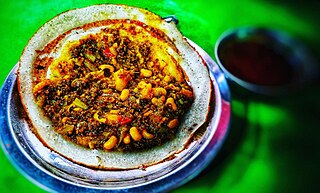 W
WAylā is a Newari beverage prepared by distillation of fermented ingredients such as rice, grains and millet. Apart from casual drinking, Aila is an important part of festivals in Nepal. This liquor is usually homemade and prepared by traditional methods. Its preparation is not yet commercial in Nepal, however it is sold in restaurant that serve Newa cuisine. It is about 60% alcohol and can be bought in local Newari restaurants. CNN has noted it as being one of the "50 most delicious drinks in the world".
 W
WBaji is a type of beaten rice eaten in Nepal. The most common word for it, and the one visitors to Nepal will generally encounter, is "chiura." "Baji" is the term used by the Newar culture in the Kathmandu Valley. Rice is a staple in Nepal, as throughout South Asia. The grain is incorporated into everyday life, festivals, and rituals. Chiura is a common snack among farmers and workers in rural Nepal. The snack is made by pounding rice. The dish can be served with yogurt, curry, and or meat. Often chiura is paired with tea as a mid-morning snack in the fields.
 W
WChatānmari is a kind of rice crepe. It is a traditional specialty of the Newars of the Kathmandu Valley in Nepal and is eaten during festivals and other special occasions.
 W
WChhwela is a typical Newari dish that consists of spiced grilled buffalo meat. Though the dish is traditionally popular with water buffalo meat, nowadays mutton, chicken, duck meat and mushroom are also being used. Usually eaten with rice flakes (chiura), this dish is typically very spicy, hot and mouth watering.
 W
WChunlā is a traditional meat dish of the Kathmandu Valley in Nepal. It is meat finely chopped by a chopping knife or meat grinder. Chunlā is a popular dish in Newar cuisine and is similar to Qeema found in other parts of South Asia.
 W
WDhau is yogurt prepared by Newars of Nepal. It is traditionally made in clay pots. It can also be made in plastic cups. The most famous and delicious variety of dhau is juju dhau, which is known for its rich taste and thick consistency. Juju dhau literally means "king yogurt" in Nepal Bhasa. It is a specialty of the town of Bhaktapur.
 W
WKwāti is a mixed soup of nine types of sprouted beans. It is a traditional Newari dish consumed on the festival of Guni Punhi, the full moon day of Gunlā which is the tenth month in the Nepal Era lunar calendar. It is also known and widely consumed as Gedagudi in the Mithila Region of Nepal, historically aligned down to Kingdom of Newar. Kwāti is eaten as a delicacy and for its health benefits and ritual significance. Kwati is known to be a healthy food. It is said to cure colds and coughs, and be particularly good for pregnant women. Since it contains varieties of beans, this recipe is loaded with proteins and thus helps weak/sick people to regain their energy.
 W
WLākhāmari is a type of sweet of Newars. It is made of flour, sugar, butter and other ingredients. It can be made in different shapes and are named differently depending upon the shapes. It is customarily given to guests of marriage ceremony in some Newar subculture. Prior to marriage, the groom has to provide 'lakhamari's to the bride's family, which they will send along with the invitation card for marriage. However, lakhamaris will only be sent to close relatives. Lakhamari can be stored in dry for many days.
 W
WMomo is a type of Tibetan dumpling dish. It is popular in Tibet, Nepal, India and in the regions straddling the Himalayas between South Asia and East Asia. Momo is found in the cuisines of Nepal & Tibet. It is similar to baozi, jiaozi and mantou in Chinese cuisine, buuz in Mongolian cuisine, gyoza in Japanese cuisine, mandu in Korean cuisine and manti in Turkic cuisines, albeit heavily influenced by the cuisine of the Indian subcontinent with Indian spices and herbs. Momo is extremely popular in South Asia and can be found in every kind of shop from restaurants to street vendors.
 W
WPohaa, also known as pauwa, chira, or aval, Bajil among many other names, is flattened rice originating from the Indian subcontinent. Rice is parboiled before flattening so that it can be consumed with very little to no cooking. These flakes of rice swell when added to liquid, whether hot or cold, as they absorb water, milk or any other liquids. The thickness of the flakes varies between almost translucently thin to nearly four times thinner than a normal rice grain.
 W
WSapu Mhichā is a special dish consisting of buffalo leaf tripe stuffed with bone marrow. It is boiled and fried. Sapu Mhichā is a specialty of the Newari cuisine of the Kathmandu Valley and is prepared during special occasions.
 W
WYomari, also called Yamari, is a delicacy of the Newar community in Nepal. It is a steamed dumpling that consists of an external covering of rice flour with sweet fillings such as chaku. The delicacy plays a very important role in Newaa society, and is a key part of the festival of Yomari punhi. According to some, the triangular shape of the yamari is a symbolical representation of one half of the shadkona, the symbol of Saraswati and wisdom.
 W
WYomari Punhi is a Newari festival marking the end of the rice harvest. It takes place in November/December during the full moon day of Thinlā (थिंला), the second month in the lunar Nepal Era calendar.